MILP-Based Optimization of Electric Bus Charging Considering Battery Degradation and Environmental Factors Under TOU Pricing
Abstract
1. Introduction
2. Proposed EB Charging Strategy
3. Optimization Cost of EB Charging and Battery Capacity Loss
4. Case Study
4.1. Case Study Design
4.2. Case Study Results
5. Conclusions
Author Contributions
Funding
Data Availability Statement
Conflicts of Interest
Abbreviations
| Time interval suffix number. | |
| Total number of time slots. | |
| EB suffix number. | |
| Total number of EBs. | |
| Trip suffix number. | |
| Total number of trips. |
Appendix A
- Input variables
- : Total energy consumed by whether EB is garaged or waiting at time (0–1 binary, waiting = 1).: Amount of energy consumed by EB driving at time .: Amount of energy consumed by EB for heating and cooling at time .: Distance of route covered by EB .: Trip time for EB ’s trip.: EB ambient temperature at time .: Heating start temperature.: Cooling start temperature.: Charging cost for each load hour at time .: Battery unit cost per kWh.: Battery capacity of EB, .: End of battery life criteria.: Weighting to account for depreciation when selling used batteries.: Parameters based on cell temperature for estimating battery capacity loss due to cycle aging.: Cell temperature-dependent parameters for estimating battery capacity loss due to calendar aging.: DoD-specific parameters for estimating battery capacity loss due to cycle aging.: SoC-specific parameters for estimating battery capacity loss due to calendar aging.: Lower bound SoC.: Upper limit SoC.: Minimum number of charge duration intervals.: Total number of chargers.: Maximum charging power.: Time suffix number at which all operations end.: Time interval number at which the charging schedule ends.: Constant to convert power to the amount of power used during .: Constant for converting power to SoC value on the EB.: Whether EB is garaged or waiting at time (0–1 binary, waiting = 1).
- Decision variable
- : Charging power of EB at time : SoC on EB at time .: Percentage loss of battery capacity on EB at time .: Percentage of battery capacity loss due to cycle aging on EB at time .: Percentage of battery capacity loss due to calendar aging on EB at time .: Whether EB is charging at time (0–1 binary, charging = 1).: Whether EB starts charging at time (0–1 binary, start = 1).: Whether EB is terminating charging at time (0–1 binary, end = 1).
Appendix B




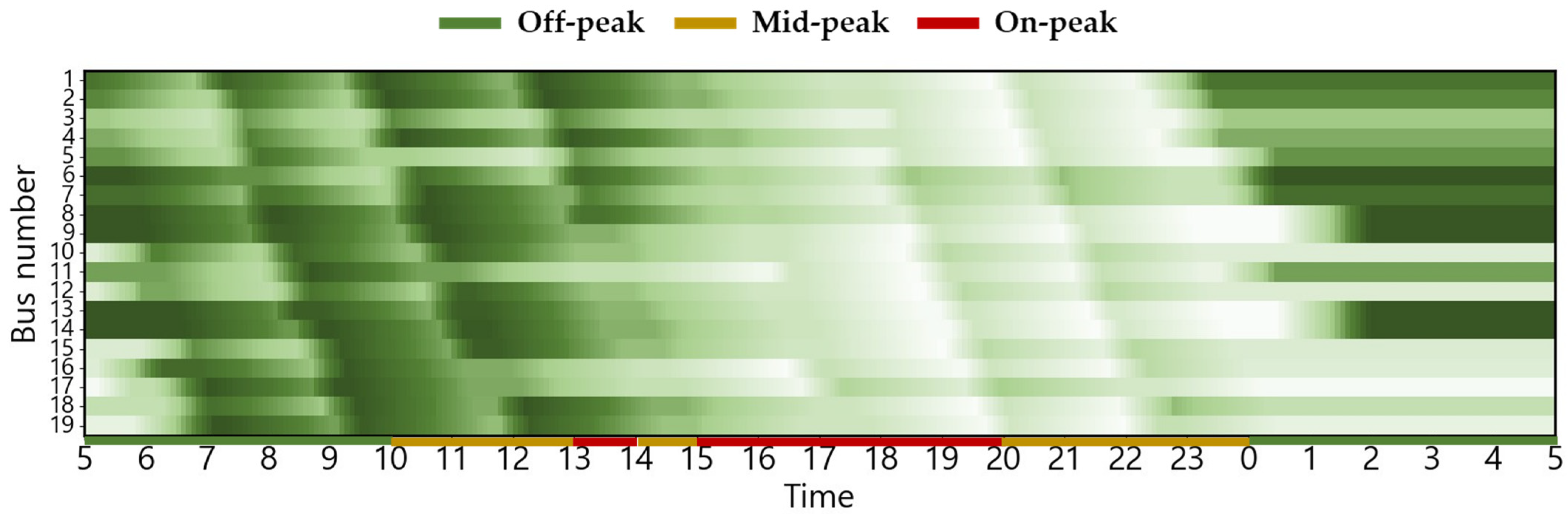




References
- IEA. Available online: https://www.iea.org/energy-system/transport (accessed on 1 August 2025).
- Statista. Available online: https://www.statista.com/statistics/1129656/global-share-of-co2-emissions-from-fossil-fuel-and-cement/ (accessed on 1 August 2025).
- Borne, I.; Souza, S.A.S.d.; Carniatto Silva, E.T.; Soares, G.B.; Gimenez Ledesma, J.J.; Ando Junior, O.H. Sustainable mobility: Analysis of the implementation of electric bus in university transportation. Energies 2025, 18, 2195. [Google Scholar] [CrossRef]
- Bao, Z.Y.; Li, J.P.; Bai, X.H.; Xie, C.; Chen, Z.B.; Xu, M.; Shang, W.L.; Li, H.L. An optimal charging scheduling model and algorithm for electric buses. Appl. Energy 2023, 332, 120512. [Google Scholar] [CrossRef]
- Zheng, F.F.; Wang, Z.J.; Liu, M. Overnight charging scheduling of battery electric buses with uncertain charging time. Oper. Res. 2022, 22, 4865–4903. [Google Scholar] [CrossRef]
- Diego, C.; Jakub, G.; Christian, M. Energy Logistics Cost Study for Wireless Charging Transportation Networks. Sustainability 2021, 13, 5986. [Google Scholar] [CrossRef]
- Li, T.T.; Zhang, W.C.; Huang, G.S.; He, H.C.; Xie, Y.; Zhu, T.X.; Liu, G.T. Real-world data-driven charging strategies for incorporating health awareness in electric buses. J. Energy Storage 2024, 92, 112064. [Google Scholar] [CrossRef]
- Jin, K.; Li, X.R.; Wang, W.; Hua, X.D. Cost-Optimal Charging Strategies for electric bus Fleets Considering Battery Degradation and Nonlinear Charging. IEEE Trans. Intell. Transp. Syst. 2024, 25, 6212–6222. [Google Scholar] [CrossRef]
- Houbbadi, A.; Redondo-Iglesias, E.; Pelissier, S.; Trigui, R.; Bouton, T. Smart charging of electric bus fleet minimizing battery degradation at extreme temperature conditions. In Proceedings of the 2021 IEEE Vehicle Power and Propulsion Conference (VPPC), Gijon, Spain, 25–28 October 2021. [Google Scholar]
- Ma, X.L.; Miao, R.; Wu, X.K.; Liu, X.L. Examining influential factors on the energy consumption of electric and diesel buses: A data-driven analysis of large-scale public transit network in Beijing. Energy 2021, 216, 119196. [Google Scholar] [CrossRef]
- Wang, G.; Fang, Z.H.; Xie, X.Y.; Wang, S.; Sun, H.J.; Zhang, F.; Liu, Y.H.; Zhang, D.S. Pricing-aware Real-time Charging Scheduling and Charging Station Expansion for Large-scale electric buses. ACM Trans. Intell. Syst. Technol. 2021, 12, 26. [Google Scholar] [CrossRef]
- Liu, X.H.; Qu, X.B.; Ma, X.L. Optimizing electric bus charging infrastructure considering power matching and seasonality. Transp. Res. Part D Transp. Environ. 2021, 100, 103057. [Google Scholar] [CrossRef]
- Cigarini, F.; Schminkel, P.; Sonnekalb, M.; Best, P.; Göhlich, D. Determination of improved climatic conditions for thermal comfort and energy efficiency in electric buses. Appl. Ergon. 2022, 105, 103856. [Google Scholar] [CrossRef]
- Xing, Y.; Fu, Q.B.; Li, Y.C.; Chu, H.S.; Niu, E.Y. Optimal Model of electric bus Scheduling Based on Energy Consumption and Battery Loss. Sustainability 2023, 15, 9640. [Google Scholar] [CrossRef]
- Würtz, S.; Bogenberger, K.; Göhner, U.; Rupp, A. Towards Efficient Battery electric bus Operations: A Novel Energy Forecasting Framework. World Electr. Veh. J. 2024, 15, 27. [Google Scholar] [CrossRef]
- Zaneti, L.A.L.; Arias, N.B.; de Almeida, M.C.; Rider, M.J. Sustainable charging schedule of electric buses in a University Campus: A rolling horizon approach. Renew. Sustain. Energy Rev. 2022, 161, 112276. [Google Scholar] [CrossRef]
- Chen, Q.Z.; Niu, C.M.; Tu, R.; Li, T.Z.; Wang, A.; He, D.B. Cost-effective electric bus resource assignment based on optimized charging and decision robustness. Transp. Res. Part D Transp. Environ. 2023, 118, 103724. [Google Scholar] [CrossRef]
- Li, P.S.; Jiang, M.Y.; Zhang, Y. Cooperative Optimization of Bus Service and Charging Schedules for a Fast-Charging Battery electric bus Network. IEEE Trans. Intell. Transp. Syst. 2023, 24, 5362–5375. [Google Scholar] [CrossRef]
- Fan, D.M.; Feng, Q.; Zhang, A.B.; Liu, M.M.; Ren, Y.; Wang, Y.P. Optimization of Scheduling and Timetabling for Multiple Electric Bus Lines Considering Nonlinear Energy Consumption Model. IEEE Trans. Intell. Transp. Syst. 2024, 25, 5342–5355. [Google Scholar] [CrossRef]
- Zhang, L.; Wang, S.A.; Qu, X.B. Optimal electric bus fleet scheduling considering battery degradation and non-linear charging profile. Transp. Res. Part E Logist. Transp. Rev. 2021, 154, 102445. [Google Scholar] [CrossRef]
- Zhou, Y.; Meng, Q.; Ong, G.P. Electric bus Charging Scheduling for a Single Public Transport Route Considering Nonlinear Charging Profile and Battery Degradation Effect. Transp. Res. Part B Methodol. 2022, 159, 49–75. [Google Scholar] [CrossRef]
- Saner, C.B.; Trivedi, A.; Srinivasan, D. A Multi-Module Modeling and Optimization Framework for Integrated Planning and Operation of electric bus Shuttle Fleets. IEEE Trans. Intell. Transp. Syst. 2024, 25, 16910–16924. [Google Scholar] [CrossRef]
- Gkiotsalitis, K.; Rizopoulos, D.; Merakou, M.; Iliopoulou, C.; Liu, T.; Cats, O. Electric bus charging station location selection problem with slow and fast charging. Appl. Energy 2025, 382, 125242. [Google Scholar] [CrossRef]
- Jiang, M.Y.; Zhang, Y.; Zhang, Y. A Branch-and-Price Algorithm for Large-Scale Multidepot Electric Bus Scheduling. IEEE Trans. Intell. Transp. Syst. 2023, 24, 15355–15368. [Google Scholar] [CrossRef]
- Sayfutdinov, T.; Ali, M.; Khamisov, O. Alternating direction method of multipliers for the optimal siting, sizing, and technology selection of Li-ion battery storage. Electr. Power Syst. Res. 2020, 185, 106388. [Google Scholar] [CrossRef]
- Tomizawa, Y.; Ihara, Y.; Kodama, Y.; Iino, Y.; Hayashi, Y.; Ikeda, O.; Yoshinaga, J. Multipurpose Charging Schedule Optimization Method for electric buses: Evaluation Using Real City Data. IEEE Access 2022, 10, 56067–56080. [Google Scholar] [CrossRef]
- Hu, H.; Du, B.; Liu, W.; Perez, P. A joint optimisation model for charger locating and electric bus charging scheduling considering opportunity fast charging and uncertainties. Transp. Res. Part C Emerg. Technol. 2022, 141, 103732. [Google Scholar] [CrossRef]
- Basma, H.; Mansour, C.; Haddad, M.; Nemer, M.; Stabat, P. Comprehensive energy modeling methodology for battery electric buses. Energy 2020, 207, 118241. [Google Scholar] [CrossRef]
- Perugu, H.; Collier, S.; Tan, Y.; Yoon, S.; Herner, J. Characterization of battery electric transit bus energy consumption by temporal and speed variation. Energy 2023, 263, 125914. [Google Scholar] [CrossRef]
- Electricity Table KEPCO ON. Available online: https://online.kepco.co.kr/PRM004D00 (accessed on 1 August 2025).
- Weather Data Opening Portal KMA. Available online: https://data.kma.go.kr/data/grnd/selectAsosRltmList.do?pgmNo=36 (accessed on 1 August 2025).
- Busan Bus Information Management System. Available online: http://bus.busan.go.kr/ (accessed on 1 August 2025).
- Kakao Map. Available online: https://map.kakao.com/ (accessed on 1 August 2025).
- Ministry of Land, Infrastructure and Transport_(TAGO)_Bus Location Information, Public Data Portal. Available online: https://www.data.go.kr/tcs/dss/selectApiDataDetailView.do?publicDataPk=15098533 (accessed on 1 August 2025).

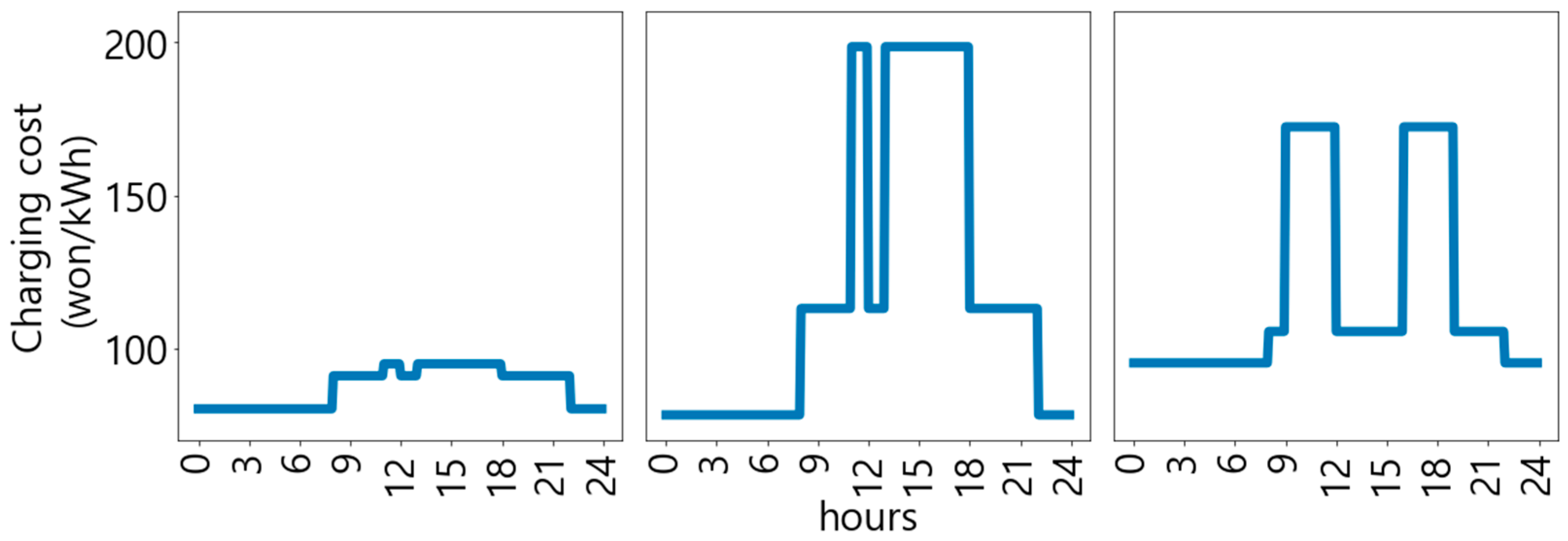
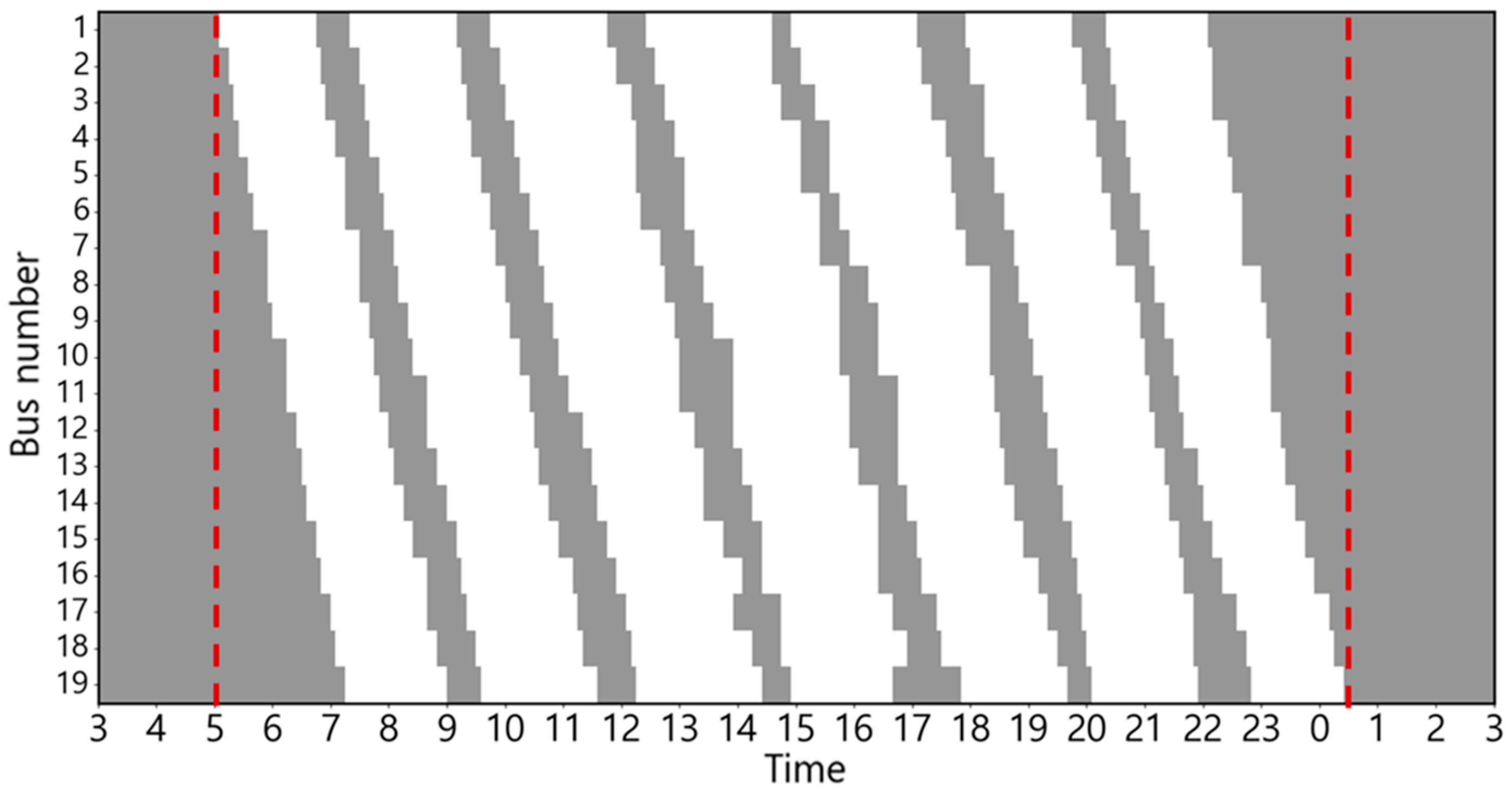

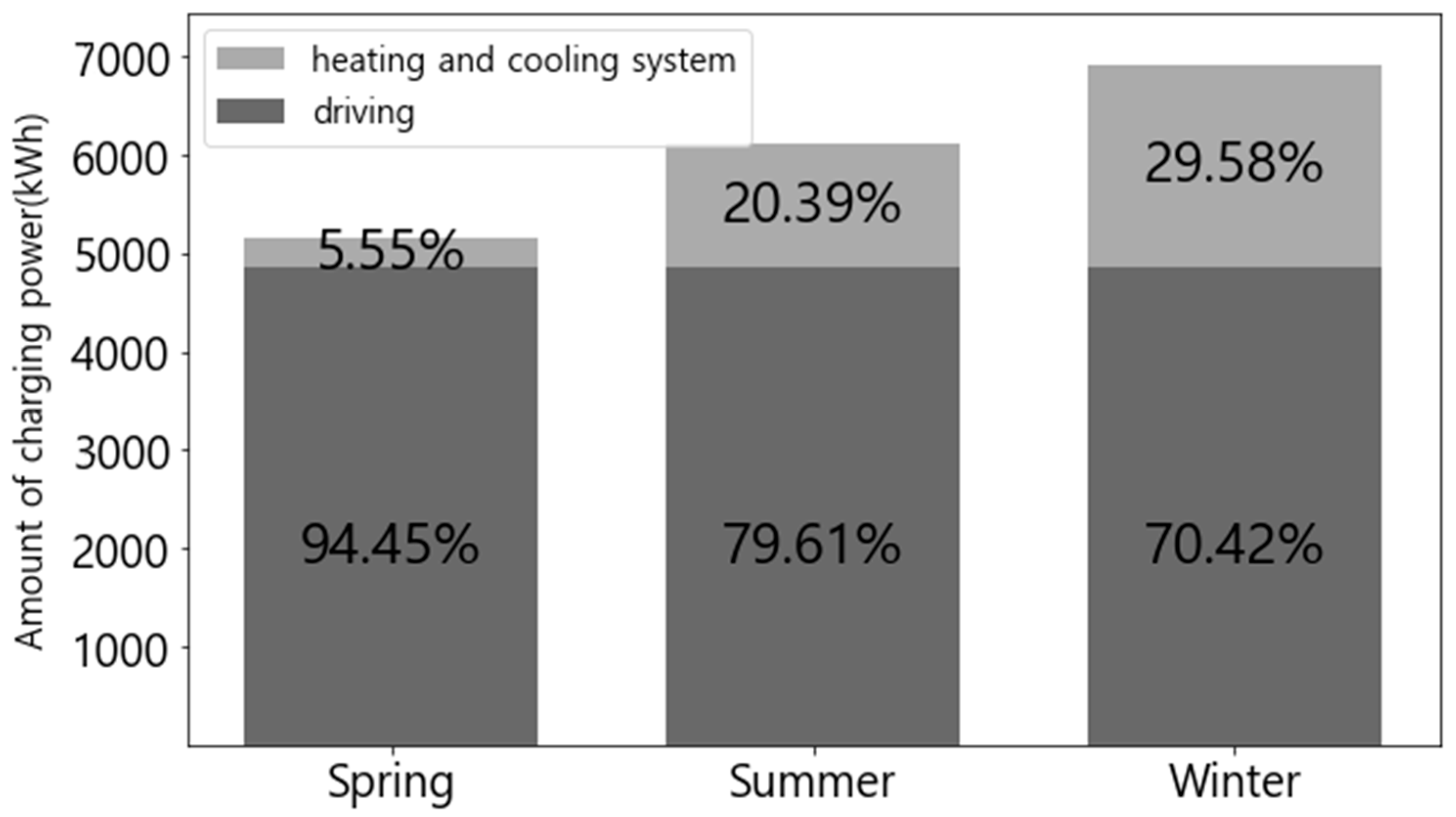



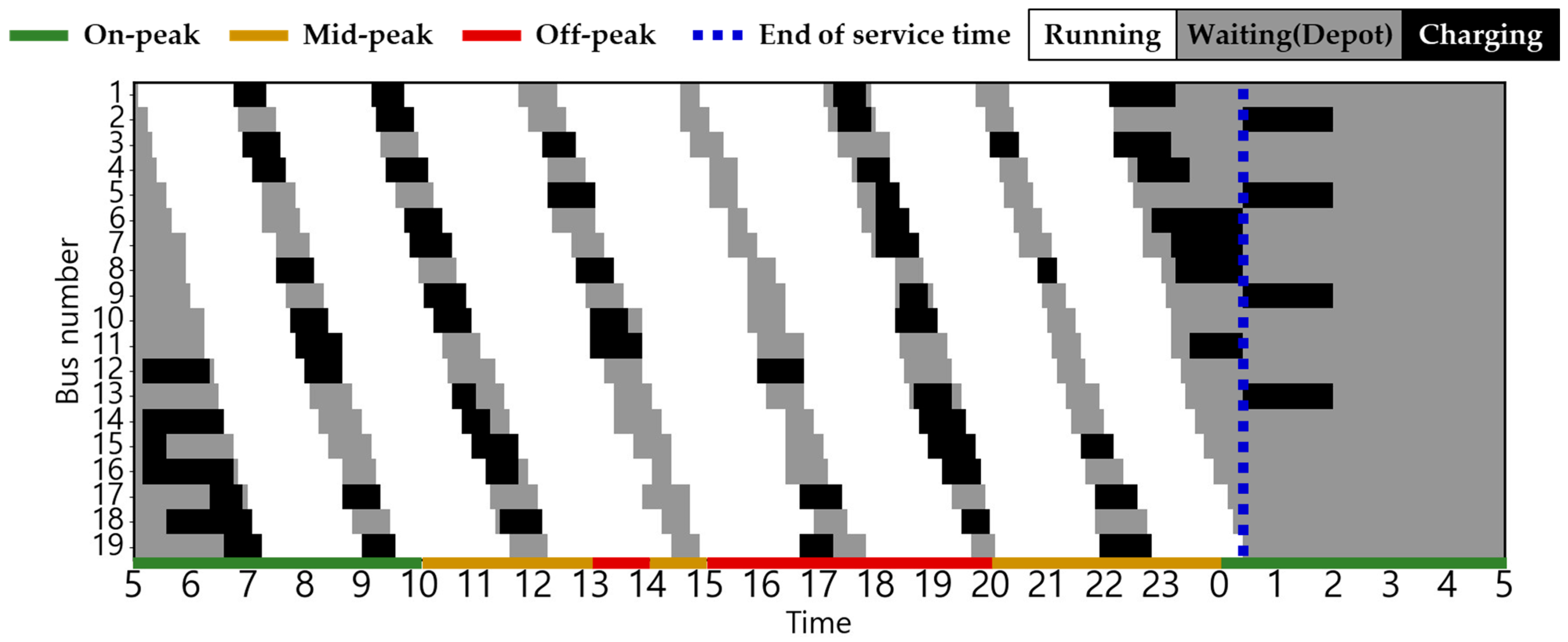
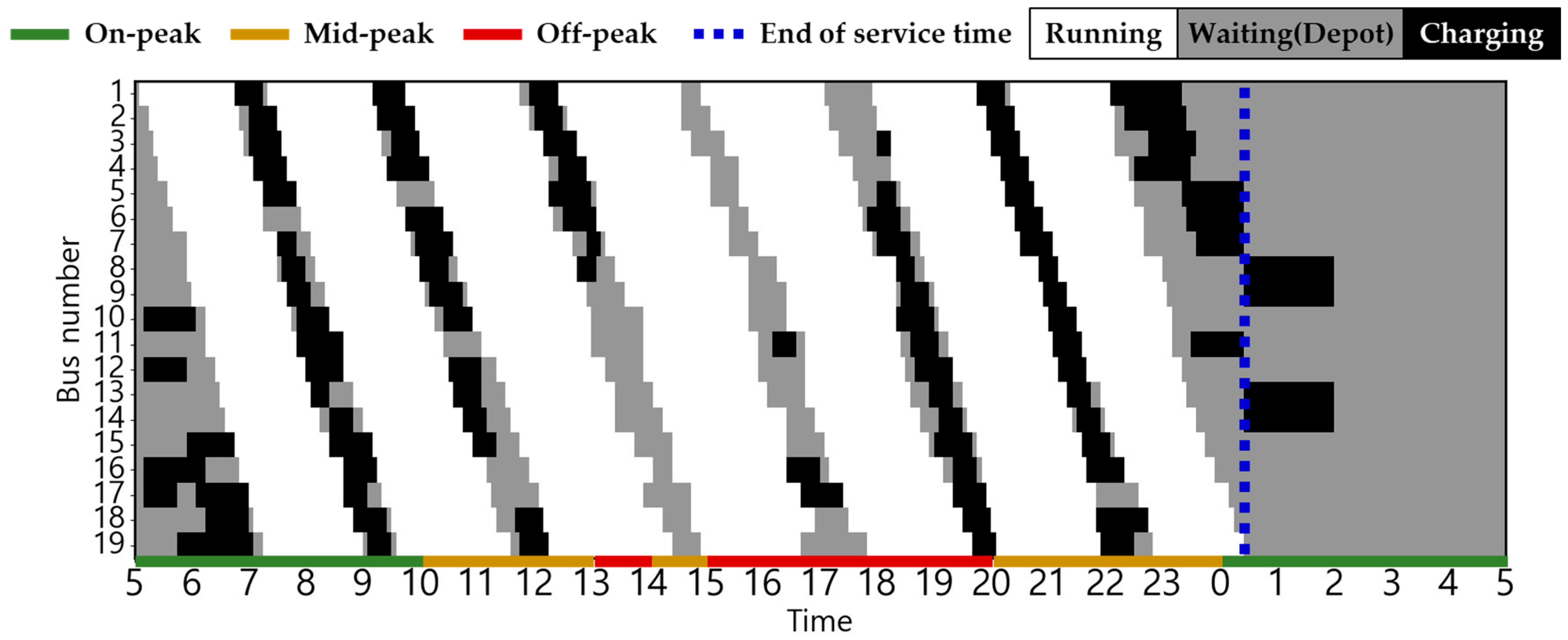
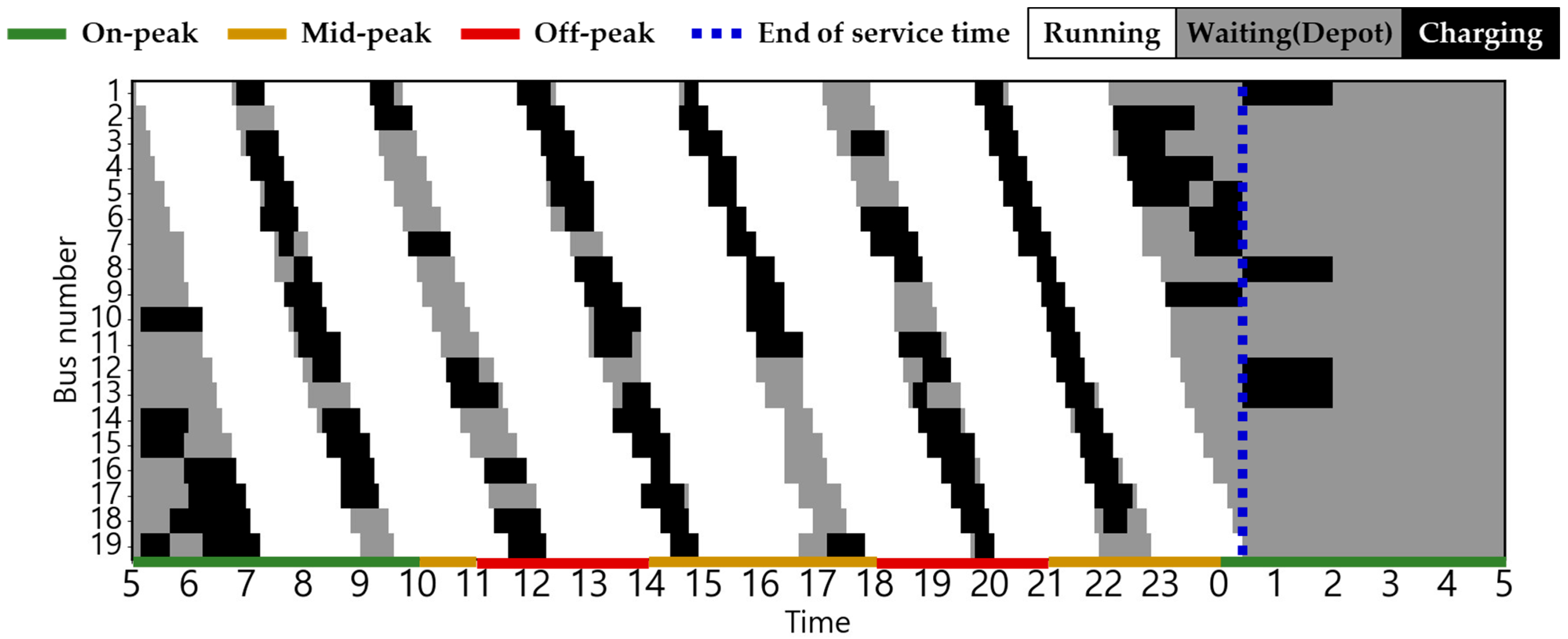

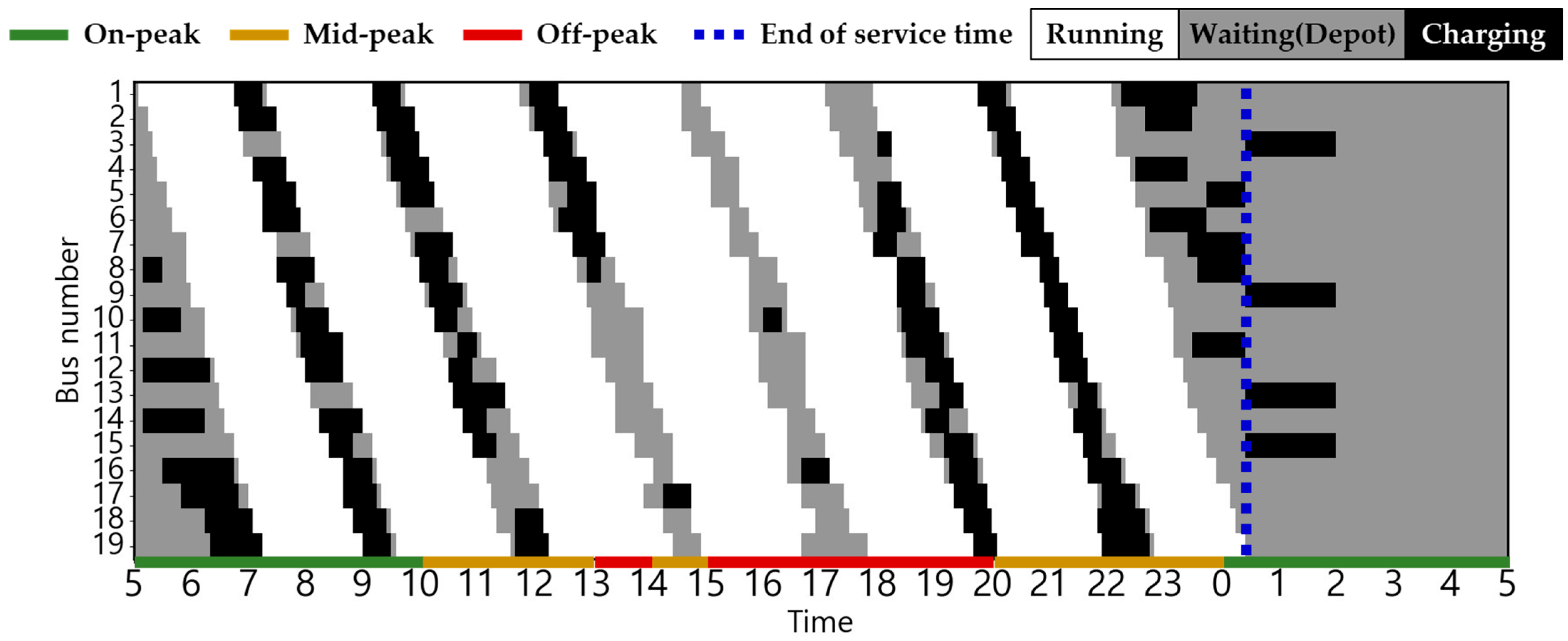

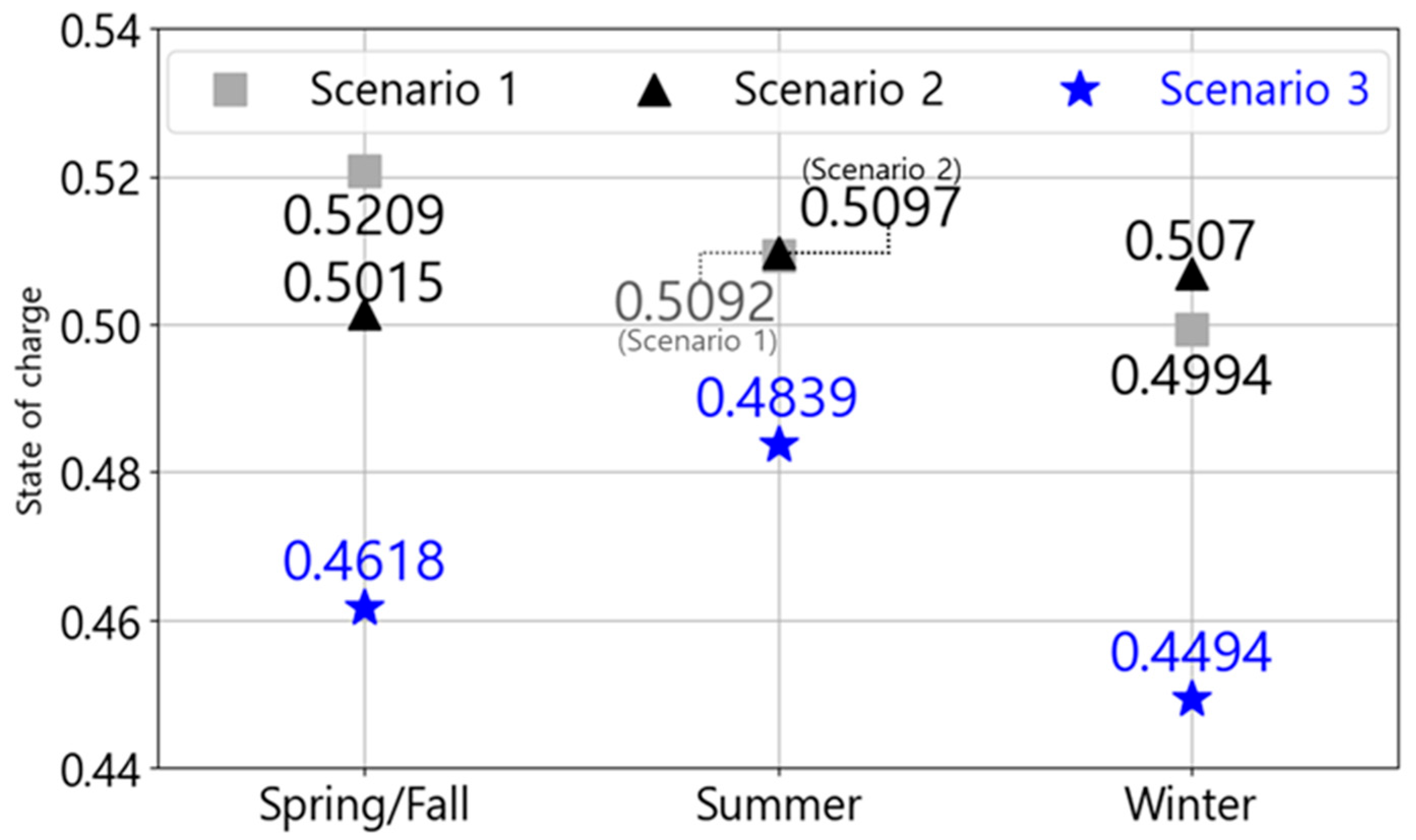

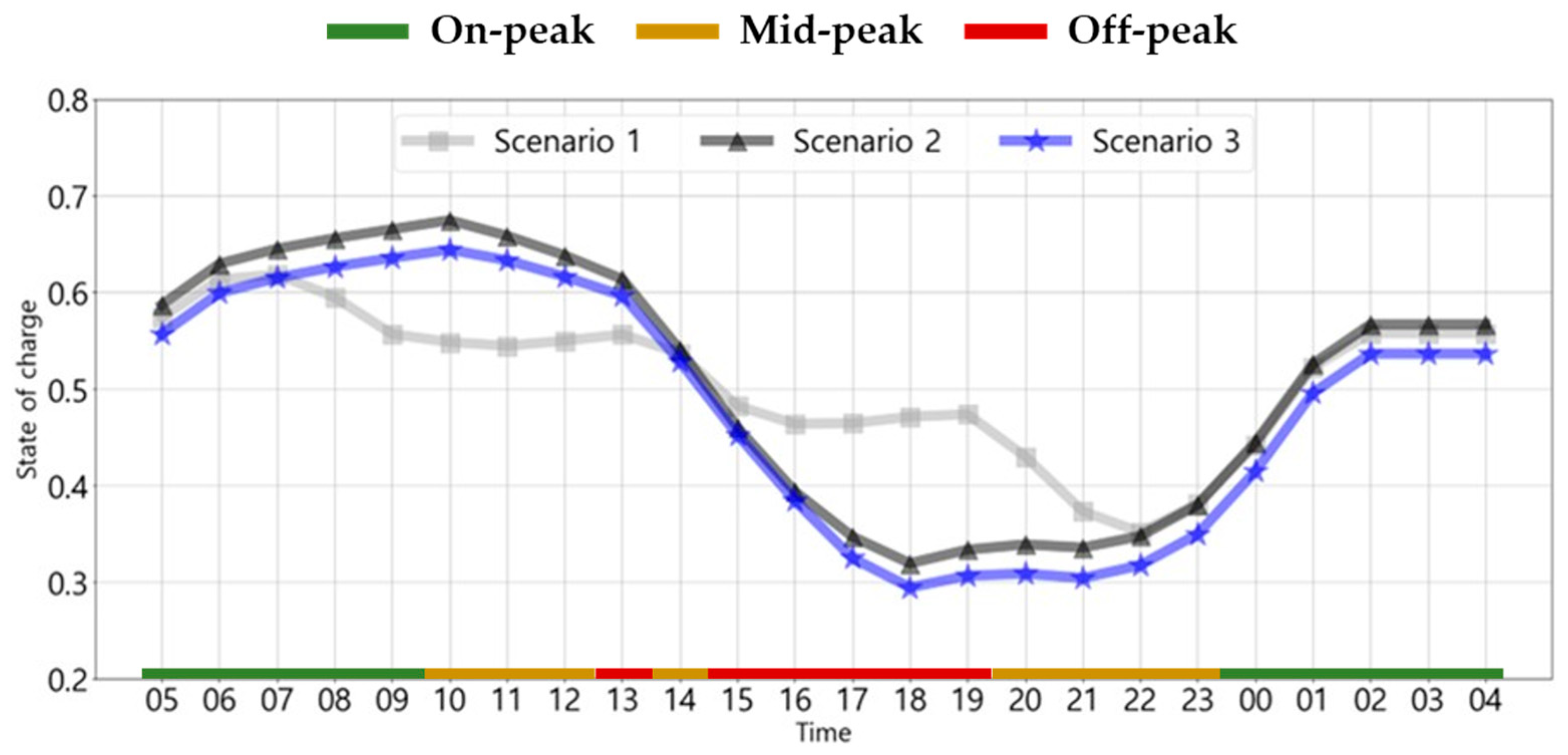
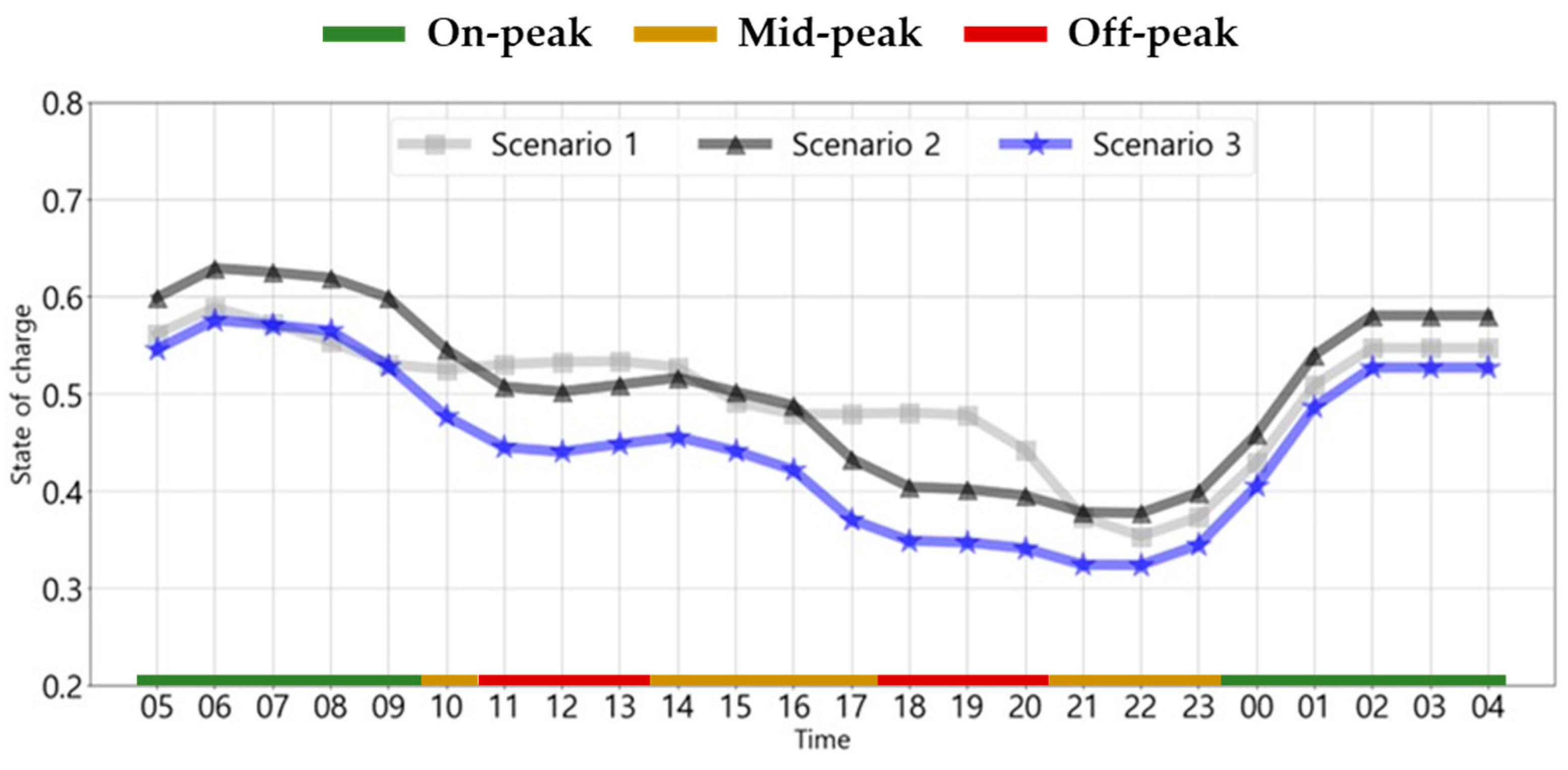
| ToU | Battery Aging | |
|---|---|---|
| Scenario 1 | not considered | not considered |
| Scenario 2 | considered | not considered |
| Scenario 3 | considered | considered |
| 256 | 150,000 | ||||
| 0.2 | 0.8 | 235 | |||
| 4 | 100 | 288 | |||
| 3 | 0.0833 |
Disclaimer/Publisher’s Note: The statements, opinions and data contained in all publications are solely those of the individual author(s) and contributor(s) and not of MDPI and/or the editor(s). MDPI and/or the editor(s) disclaim responsibility for any injury to people or property resulting from any ideas, methods, instructions or products referred to in the content. |
© 2025 by the authors. Licensee MDPI, Basel, Switzerland. This article is an open access article distributed under the terms and conditions of the Creative Commons Attribution (CC BY) license (https://creativecommons.org/licenses/by/4.0/).
Share and Cite
Seo, Y.-B.; Park, S.-W.; Son, S.-Y. MILP-Based Optimization of Electric Bus Charging Considering Battery Degradation and Environmental Factors Under TOU Pricing. Energies 2025, 18, 6028. https://doi.org/10.3390/en18226028
Seo Y-B, Park S-W, Son S-Y. MILP-Based Optimization of Electric Bus Charging Considering Battery Degradation and Environmental Factors Under TOU Pricing. Energies. 2025; 18(22):6028. https://doi.org/10.3390/en18226028
Chicago/Turabian StyleSeo, Ye-Bin, Sung-Won Park, and Sung-Yong Son. 2025. "MILP-Based Optimization of Electric Bus Charging Considering Battery Degradation and Environmental Factors Under TOU Pricing" Energies 18, no. 22: 6028. https://doi.org/10.3390/en18226028
APA StyleSeo, Y.-B., Park, S.-W., & Son, S.-Y. (2025). MILP-Based Optimization of Electric Bus Charging Considering Battery Degradation and Environmental Factors Under TOU Pricing. Energies, 18(22), 6028. https://doi.org/10.3390/en18226028







